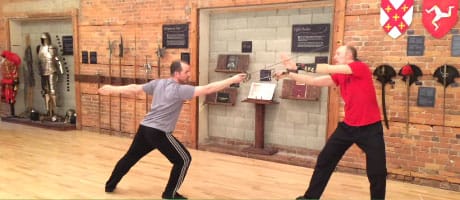Prerequisite: This course assumes the knowledge of the three Rapier Fundamentals courses.
A unified defense not only makes the offhand a useful secondary, but sets us up with a system that can later be employed with other secondaries like the dagger, buckler, cloak, baton and even a second sword.
Offhand Support: As we enter into the topic of rapier and offhand, we’ll be focusing on the fundamental position of the offhand to defend on its own as well as to accompany the defense of the rapier itself. Then we use the contra tempo opportunity to place the offhand in its supporting position.
Primary Defense: We begin to make the offhand more active by performing parries when our sword is no longer in control. Then the sword is activated and our parry-counter is complete, with the offhand performing the primary defense, and the sword set in position to make a simultaneous attack.
Stringere: Our focus is on stringering the sword of our opponent with both the sword, through finding, and with the offhand itself. The goal of stringere is to get your opponent to move in a way that you can easily defend and that makes your opponent vulnerable to counter-attack. A strong emphasis is given on using the rapier and offhand in union to fully protect one side of the body or the other both high and low. I recommend Apprentice students also look at the Rapier Scholar Offhand & Dagger classes for even more ideas on primary stringere with the offhand.
Defeating the Offhand: These two lessons represent the wrap-up of our course on use of the offhand and as is often the case we conclude our last lessons with techniques you can use to counter everything that has come before. The first video will help you with the fundamentals of getting around the offhand parry of your opponent when they start in an open position, and the second when they are in a closed position.
Acknowledgement of Safety and Risk
- Practice all exercises slowly and with control.
- Practice using training swords that are not sharp and are specifically made for practice.
- Use protective gear for all exercises. In many of our videos we are not wearing head, throat or body protection in order to make clear explanation more possible. You should always use protective gear when practicing these arts regardless of the exercise.
- Be aware that injuries in training are always possible. Ensure that you are practicing with care and caution at all times.
- DuelloTV is not responsible for any injuries that occur as a result of sword practice inspired from our videos.
